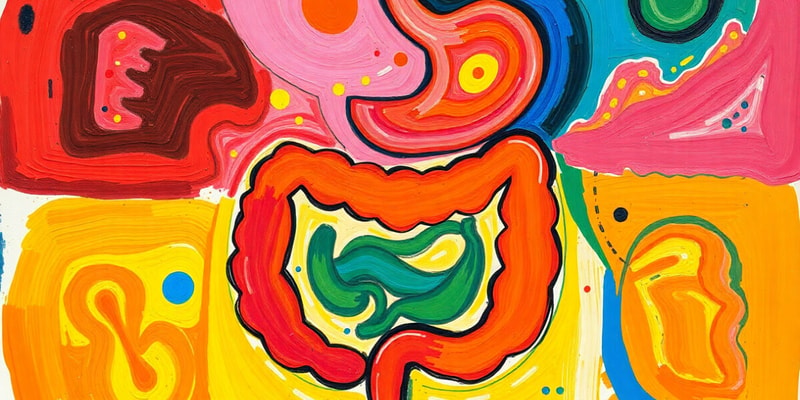Podcast Beta
Questions and Answers
What is the primary function of lacteals in the digestive system?
Which process is specifically characterized by the rhythmic contractions of the digestive tract?
What is the role of the sphincters in the digestive system?
Which enzyme in the stomach begins the process of protein digestion?
Signup and view all the answers
What is the primary function of villi in the small intestine?
Signup and view all the answers
Which component released in the stomach helps to break down fibrous tissue and kill bacteria?
Signup and view all the answers
What is the main role of the large intestine in digestion?
Signup and view all the answers
What is the main function of saliva in the digestive process?
Signup and view all the answers
Study Notes
Digestion Overview
- Ingestion: Taking food or nutrients into the body.
- Digestion: Breaking down and absorbing food.
- Egestion: Eliminating unabsorbed waste materials.
Digestive Tract
- Peristalsis: Rhythmic muscle contractions that move food through the digestive system, allowing you to eat against gravity.
- Sphincters: Rings of muscles that control the movement of food and prevent backflow.
Types of Digestion
- Mechanical Digestion: Physical breakdown of food using chewing, muscular movements, and emulsification (using saliva as a lubricant and to increase hydration during chewing).
- Chemical Digestion: Breakdown of food using enzymes produced by glands.
Absorption in the Digestive System
- Lactiles help absorb fats.
- Villi increase surface area for absorption, located in the small intestine, allowing for efficient nutrient absorption into the bloodstream.
- Capillaries surround each villi to absorb the nutrients.
The Mouth: Physical and Chemical Digestion
-
Physical Digestion:
- Incisors: Cut food.
- Canines: Tear and rip food.
- Molars: Grind food.
- Tongue: Moves food.
-
Chemical Digestion:
- Saliva: Moistens food.
- Amylase: Enzyme found in saliva that breaks down starch.
The Stomach: Physical and Chemical Digestion
- Physical Digestion: Stores and mixes food.
-
Chemical Digestion:
- Hydrochloric Acid: Breaks down fibrous tissue, kills bacteria.
- Gastric Fluids: Approximately 2 Liters are released by the stomach lining per day.
- Mucus: Protects the stomach lining from the acidity.
- Pepsin: Enzyme that begins protein digestion.
Large Intestine Purpose
- Concentrates material: Absorbs water.
- Stores feces: A mixture of undigested and unabsorbed material, water, and bacteria.
- Bacteria: Produce vitamins.
Bonus Notes & Facts:
- Pharynx: Controls the passage of air to the trachea and lungs or food to the esophagus.
- Liver: Produces bile, an enzyme that helps break down fats and other substances for the small intestine.
Studying That Suits You
Use AI to generate personalized quizzes and flashcards to suit your learning preferences.
Related Documents
Description
This quiz covers essential concepts of digestion, including ingestion, digestion, and egestion. It delves into the types of digestion—mechanical and chemical—and explores the digestive tract's anatomy and function, including peristalsis and sphincters. Test your understanding of how nutrients are absorbed in the body!




